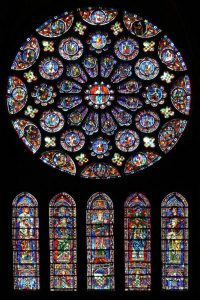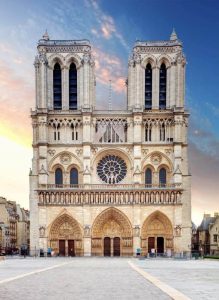Last month, a raging fire destroyed Notre Dame Cathedral extensively. History witnessed the Dame endured not only the destructions but also the ruination and subsequent restoration in many periods, states Monika. Here’s the first part of the three-part series on Notre Dame, as part of a new weekly column that we begin this week, exclusively for Different Truths.
 Notre Dame Cathedral, marvel of the 12th century was engulfed in raging flames on Monday, 15th April 2019, that annihilated the Parisian guiding light. A humongous loss not only for The City of Lights but the whole world.
Notre Dame Cathedral, marvel of the 12th century was engulfed in raging flames on Monday, 15th April 2019, that annihilated the Parisian guiding light. A humongous loss not only for The City of Lights but the whole world.
The Cathedral, which took two centuries to build, in Paris is one of the most archetypal landmarks in a city that’s already filled with quintessential monuments. A religious home, a historical and architectural marvel, this Enchanting Lady is visited by almost 15 million people a year.
The searing impact the fire made that devoured parts of the beautiful monument was a tragic event to witness. Almost eighty percent of Notre Dame’s roof was charred, making most of the interior open to the sky.
The searing impact the fire made that devoured parts of the beautiful monument was a tragic event to witness. Almost eighty percent of Notre Dame’s roof was charred, making most of the interior open to the sky. The 295-foot spire burned and hit the debris below however the classical Twin Bell towers remained undamaged. These were famed by Victor Hugo in his classic, The Hunchback of Notre Dame. It is a home to thirteen tonnes weighing, Emmanuel Bell and iconic Rose Windows.
The fire in this portion escalated very quickly because the medieval gothic cathedral is surrounded and supported by a gigantic forest of 12th-century oak trees. Probably, re-building the intricate latticework on wooden beams and frames will be a challenge. But nothing is impossible, they say.
In 1220, almost 21 hectares of 800-year-old oak beams were cut from the nearby forest that were included to enhance the gothic architecture.
In 1220, almost 21 hectares of 800-year-old oak beams were cut from the nearby forest that was included to enhance the gothic architecture. Each beam that supports the main roof was constructed from a single tree, calling for almost 13,000 individual trees altogether. No wonder, that’s the reason, the whole framework that braces the Notre Dame’s roof, is known as La Forêt / The Forest.
To describe this gorgeous lady of Paris is immensely a challenging job because beauty lies in the eyes. Capturing it in words is surely an intricate work. So, I’m trying to capture the beauty and visualise it for the readers who are lovers of beauty.
Here are few random facts on the Gothic masterpiece that celebrated its 850th jubilee in 2013.
Notre Dame is located on the Paris Island called Ile de la Cite, which bore the power and the politics of France between the 4th and the 14th century.
The south tower houses the 13-tonne Emmanuel bell.
Dame is approximately 420 ft. long, 158 ft. wide and towers’ height is 226 ft. The cathedral pillars have a diameter of 16 ft. The twin towers go as high as 387 steps of 227 ft. The south tower houses the 13-tonne Emmanuel bell. The rose windows have a diameter of 33 ft.
The stunning cathedral is referred to as: “Notre Dame de Paris” (“Our Lady of Paris”) in French, the “Notre Dame Cathedral” or sometimes just simply “Notre Dame”.
Previous Destructions and Restoration
History witnessed Notre Dame endured not only the current destruction but also ruination and subsequent restoration in many periods. But each time, Dame has given interiors and a face much true to the original impression.
Many features on the cathedral’s exterior were vandalised because they were considered to be idolatrous.
Dating back to 16th century, the French king and Huguenots savaged the edifice and premises. Reason being, many features on the cathedral’s exterior were vandalised because they were considered to be idolatrous. One of the massive pillars at the central doorway was demolished to allow grand processional carriages to pass through. The Dame unfortunately had to face a radical and contentious transformation.
The chancel screen, an orntated partition was brought down and destroyed. The colour-glass windows from the 12th and 13th centuries were replaced with clear glass because the former ones were regarded as the representation of modernity. Currently, only the three Notre Dame rose windows have retained the original glazing.
Damage from the French Revolution
She suffered further damage and devastation during the French Revolution from 1787 – 99 symbolising the power and belligerence of the monarchy.
The sad story did not stop there. This Lady had much more to witness. She suffered further damage and devastation during the French Revolution from 1787 – 99 symbolising the power and belligerence of the monarchy. The epitome of beauty was again ransacked; statues and sculptures were ruined. Not only lead from the roof was cannabalised for bullets but several bronze bells were melted down to make cannons. By the end of the revolution, what they say, Notre Dame was a shadow of its former self and had been de-Christianised.

Damage from the First World War
In 1914, more than two dozen German shells hit the cathedral and the wooden catafalque/scaffolding was set on fire, which in turn lit the oak of the roof.
Notre Dame was damaged during the First World War too. In 1914, more than two dozen German shells hit the cathedral and the wooden catafalque/scaffolding was set on fire, which in turn lit the oak of the roof. The lead of the roof melted further amplifying the fire. Stained-glass windows, carved beams and statues were destroyed.
Surviving the Second World War
During French Revolution, many statues, sculptures were broken and beheaded. The cathedral was converted into a food and fodder warehouse.
During the Second World War, the repeated attack was feared but many  precautionary acts were taken. The medieval stained rose window panes were removed and reinstalled only after the war had ended. During the French Revolution, many statues, sculptures were broken and beheaded. The cathedral was converted into a food and fodder warehouse.
precautionary acts were taken. The medieval stained rose window panes were removed and reinstalled only after the war had ended. During the French Revolution, many statues, sculptures were broken and beheaded. The cathedral was converted into a food and fodder warehouse.
In the mid-19th century, an effort for restoration was initiated. Along with the repairs, there were few more art and architectural enhancements. The most recent restoration program to clean and restore the facade was started in 1991 for the next two decades.
Notre Dame Cathedral: A Brief History
Notre Dame undoubtedly remains one of the most outstanding monuments all over the world. The 800 years old vintage Catholic is located in the middle of the river Seine, on a small island called the Ile de la Cite. The monument was completed over the course of 200 years; it was started in 1163 during the reign of King Louis VII and was completed in 1345.
The Dame of Paris has its own share of both the glorious and the tragic historical moments that are imperishable in the mind of people worldwide.
The Dame of Paris has its own share of both the glorious and the tragic historical moments that are imperishable in the mind of people worldwide. The historic crowning of Henry VI of England took place right inside the cathedral in 1431. The Cathedral at one time was in a stage absolute ruination and close to the point of being dismantled. Napoleon who himself has crowned Emperor in 1804 inside the Cathedral came as a saviour.
The history of the Notre Dame would not be complete without considering the story of Joan of Arc, a peasant girl who is well instanced in the history books of not only France but rest of the world as well.
On the 7th of July 1456, Joan of Arc was declared innocent and a martyr. In 1909, she was beatified in the famous Notre Dame cathedral in Paris by Pope Pius X.
 She was materialistically a poor girl but was rich spiritually. A courageous girl and claimed that she had visions from God. Through her visions and bravery, France implemented the war-tactics of Joan of Arc to fight against English troops and France won many fights against England. A great supporter of the monarchy, she is indirectly the reason why Charles VII was crowned.
She was materialistically a poor girl but was rich spiritually. A courageous girl and claimed that she had visions from God. Through her visions and bravery, France implemented the war-tactics of Joan of Arc to fight against English troops and France won many fights against England. A great supporter of the monarchy, she is indirectly the reason why Charles VII was crowned.
Joan of Arc was captured by the Burundians’, accused of heresy. She was burned at the stake. But the brave girl was paid her dues. On the 7th of July 1456, Joan of Arc was declared innocent and a martyr. In 1909, she was beatified in the famous Notre Dame cathedral in Paris by Pope Pius X.
The Lady of Paris was used (before the recent fire) by the Roman Catholic Church for Sunday mass and it is the chair of the Archbishop of Paris.
References
- Wikipedia Notre-Dame de Paris.
- Janson H. W, History of Art.
- Victor Hugo, The Hunchback of Notre Dame.
- Jeremy and Jim Langford, The Spirit of Notre Dame: Legends, Traditions, and Inspiration.
- Richard Winston, Notre-Dame: A History.
Bibliography
Gothic Architecture: Architectural style that flourished in Europe during the High and Late Middle Ages. It evolved from Romanesque architecture and was succeeded by Renaissance Architecture.
- Latticework: interfacing strips of metal, wood or other material forming a lattice.
- Idolatrous: relating to idolatry, idol-worshipping.
- Monarchy: the system of government or rule by a king or queen.
- Burundian: The Republic of Burundi, a landlocked country now, amid the African Great Lakes, was once part of German East Africa.
- Catafalque: A decorated wooden framework supporting the coffin of a distinguished person during a funeral or while lying in state.
- de-christianise: remove Christian influence or characteristics from.
(To be continued)
Photos sourced by the author from the Internet






 By
By

 By
By
Monika=Great researched details-thank you!
This is such a well researched work. Hard work and painstaking details can be seen. Engrossing!